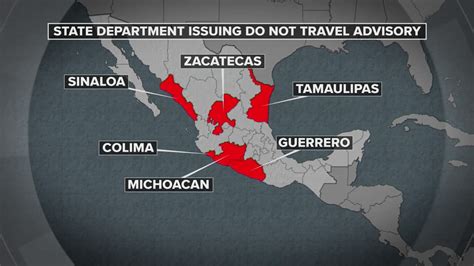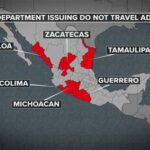
Canadians planning trips to the United States should exercise a high degree of caution due to elevated crime rates and the high cost of healthcare, according to updated travel advisories issued by the Canadian government. The advisory specifically highlights concerns about violent crime, readily available firearms, and the potential financial strain associated with seeking medical treatment in the U.S.
The updated advisory, posted on the Canadian government’s website, urges citizens to be aware of their surroundings and take necessary precautions to ensure their safety. “Exercise a high degree of caution in the United States due to high levels of violent crime,” the advisory states. The warning encompasses various forms of crime, including gun violence, which has been a persistent issue in numerous American cities.
The Canadian government also emphasizes the significant expenses associated with healthcare in the United States. The advisory warns that medical costs can be substantially higher than in Canada and that travelers should ensure they have adequate travel health insurance to cover potential medical emergencies. “Medical care can be expensive, and costs are often much higher than in Canada,” the advisory cautions. “Make sure you have adequate travel health insurance and accessible funds to cover the cost of any medical treatment abroad.”
This updated advisory reflects ongoing concerns about safety and healthcare affordability in the U.S., which have been voiced by various international entities and travel organizations. The advisory serves as a reminder for Canadians to be vigilant and well-prepared when traveling south of the border.
Specific Crime Concerns
The Canadian advisory points to the prevalence of violent crime as a primary reason for increased vigilance. While not specifying particular cities or regions, the general warning suggests that travelers should be aware of their surroundings regardless of their destination within the U.S. The ready availability of firearms is also a significant concern. The advisory does not delve into the specifics of gun control laws or the lack thereof in different states, but the implicit message is clear: Canadians should be aware that they are entering a country where firearms are more accessible than in Canada. This awareness is crucial for personal safety, particularly in public places or areas known for higher crime rates.
Beyond violent crime, the advisory also hints at other forms of criminal activity that travelers should be wary of, such as theft, scams, and petty offenses. Although these are not explicitly detailed, the overall tone of the advisory suggests that vigilance is necessary across the board.
Healthcare Costs and Insurance
The advisory’s focus on healthcare costs in the United States is particularly noteworthy. The American healthcare system is notoriously expensive, and even minor medical procedures can result in substantial bills. For Canadians accustomed to universal healthcare, this can be a significant shock. The advisory strongly recommends that travelers purchase comprehensive travel health insurance before crossing the border. This insurance should cover a wide range of potential medical expenses, including emergency room visits, hospital stays, ambulance transportation, and prescription medications.
The advisory also suggests that travelers should have access to sufficient funds to cover any unexpected medical costs. This could involve having a credit card with a high limit or setting aside a specific amount of money for potential medical emergencies. The underlying message is that relying solely on travel insurance might not be enough; having additional financial resources can provide an extra layer of security in case of unforeseen circumstances.
Travel Health Insurance Considerations
When purchasing travel health insurance, Canadians should carefully review the policy’s terms and conditions. Key considerations include:
-
Coverage Limits: Ensure that the policy has sufficient coverage limits to cover potentially high medical expenses.
-
Pre-existing Conditions: Understand how the policy treats pre-existing medical conditions. Some policies may exclude coverage for conditions that existed before the trip.
-
Deductibles: Be aware of the deductible amount, which is the amount you must pay out-of-pocket before the insurance coverage kicks in.
-
Exclusions: Review the policy’s exclusions, which are specific situations or conditions that are not covered.
-
Claim Procedures: Familiarize yourself with the policy’s claim procedures, including how to file a claim and what documentation is required.
-
24/7 Assistance: Confirm that the insurance provider offers 24/7 assistance in case of medical emergencies.
Broader Context and Implications
The Canadian government’s travel advisory to the United States is not an isolated event. It reflects broader concerns about safety and healthcare affordability in the U.S. that have been voiced by various international organizations and governments. These concerns are often amplified by media reports of gun violence, mass shootings, and the challenges faced by individuals struggling to afford medical care.
The advisory could potentially have several implications:
-
Tourism: It might deter some Canadians from traveling to the United States, particularly those who are risk-averse or concerned about healthcare costs.
-
Insurance Purchases: It could lead to an increase in the purchase of travel health insurance by Canadians traveling to the U.S.
-
Travel Planning: It might prompt Canadians to be more cautious and plan their trips more carefully, including researching crime rates in their destination areas and identifying hospitals and medical facilities.
-
Diplomatic Relations: It could potentially strain diplomatic relations between Canada and the United States, although this is unlikely unless the advisory is perceived as being overly critical or politically motivated.
Comparison to Previous Advisories
It’s important to note whether this advisory represents a significant change from previous advisories. If the language is notably stronger or if new specific concerns have been added, it suggests a heightened level of concern on the part of the Canadian government. Comparing the current advisory to previous versions can provide valuable context. Has there been a gradual escalation of warnings over time, or is this a sudden and unexpected shift? Changes in advisory language often reflect changes in the perceived risks associated with traveling to a particular country.
Public Reaction and Media Coverage
The Canadian government’s travel advisory has generated significant media coverage in both Canada and the United States. Public reaction has been mixed, with some Canadians expressing agreement with the advisory and others dismissing it as being overly cautious. In the United States, some have criticized the advisory as being unfair or inaccurate, while others have acknowledged the validity of the concerns raised. The media coverage has also sparked debate about gun control, healthcare reform, and the overall safety of the United States.
Canadian Perspective
From a Canadian perspective, the advisory reflects a deep-seated concern about the differences between the two countries in terms of safety and healthcare. Canada has a relatively low crime rate and a universal healthcare system, which means that Canadians are generally accustomed to feeling safe and secure, both physically and financially. The prospect of traveling to a country where violent crime is more prevalent and healthcare costs are significantly higher can be unsettling, particularly for those who are not familiar with the American system.
U.S. Perspective
From a U.S. perspective, the advisory may be seen as an exaggeration of the risks associated with traveling to the country. While it is true that the United States has a higher crime rate than Canada and that healthcare costs are a major concern, many Americans feel that the country is generally safe and that healthcare is accessible, particularly for those with insurance. However, it is important to acknowledge that the U.S. is a large and diverse country, and experiences can vary widely depending on the location and individual circumstances.
Long-Term Implications
The long-term implications of the Canadian government’s travel advisory remain to be seen. If the advisory remains in place for an extended period of time, it could potentially have a significant impact on tourism and economic relations between the two countries. It could also lead to a greater emphasis on cross-border cooperation in areas such as law enforcement and healthcare. Ultimately, the impact of the advisory will depend on how the situation evolves in both Canada and the United States.
The Canadian government’s warning is a reflection of the real and perceived differences in safety and healthcare accessibility between the two nations. While the advisory is intended to protect Canadian citizens, it also serves as a reminder of the ongoing challenges facing the United States in addressing issues such as gun violence and healthcare affordability. The “exercise a high degree of caution” directive is a practical piece of advice for any traveler, regardless of destination, but it carries particular weight when applied to a country with such significant disparities compared to Canada.
In conclusion, the travel advisory issued by the Canadian government underscores the importance of vigilance, preparation, and awareness for Canadians traveling to the United States. By taking appropriate precautions and staying informed, travelers can minimize their risks and enjoy a safe and healthy trip. The government’s role is to provide information to its citizens so they can make informed decisions.
FAQ: Canada’s Travel Advisory for the United States
1. Why did Canada issue this travel advisory for the U.S.?
The Canadian government issued the advisory due to concerns about high levels of violent crime and the potentially exorbitant costs of healthcare in the United States. The advisory aims to inform Canadian travelers about these risks and encourage them to take necessary precautions to ensure their safety and financial well-being. The explicit mention of firearm availability highlights a specific concern that is less prevalent in Canada.
2. What specific types of crime should Canadians be aware of when traveling to the U.S.?
The advisory highlights violent crime in general. Although specific crimes are not mentioned, the focus is on the higher incidence of violent incidents compared to Canada, coupled with the prevalence of firearms. This indirectly suggests heightened awareness of situations where violence could escalate, such as public gatherings or areas known for higher crime rates. Travelers should be aware of their surroundings and take precautions against theft, scams, and other petty offenses, though the primary emphasis remains on the more serious threat of violent crime.
3. How expensive is healthcare in the United States compared to Canada, and what kind of insurance is recommended?
Healthcare in the United States is significantly more expensive than in Canada, where universal healthcare is provided. Even minor medical procedures can result in substantial bills. The advisory recommends that Canadians purchase comprehensive travel health insurance that covers emergency room visits, hospital stays, ambulance transportation, prescription medications, and repatriation (if necessary). When choosing a policy, it is vital to consider coverage limits, pre-existing conditions, deductibles, exclusions, and claim procedures. Obtaining insurance with 24/7 assistance is also highly recommended.
4. Will this travel advisory affect tourism between Canada and the U.S.?
It’s possible. Some Canadians, particularly those who are risk-averse or concerned about healthcare costs, might choose to avoid traveling to the United States altogether. However, many Canadians will likely continue to visit the U.S. but may be more cautious and plan their trips more carefully. This might include researching crime rates in their destination areas, identifying nearby hospitals and medical facilities, and purchasing more comprehensive travel insurance. The long-term impact on tourism will depend on how the situation evolves and whether the advisory remains in place.
5. Does this advisory mean the Canadian government believes the U.S. is unsafe?
Not necessarily. The advisory indicates a perceived higher risk level compared to Canada, not an absolute declaration of unsafety. The Canadian government has a responsibility to inform its citizens about potential risks when traveling abroad. The advisory serves as a reminder that travelers should be aware of their surroundings, take precautions to protect themselves from crime, and ensure they have adequate health insurance coverage. It is a risk management tool aimed at helping Canadians make informed decisions about their travel plans, allowing them to take steps to mitigate potential threats and expenses. The advisory is not an indictment of the entire United States, but rather a targeted warning based on specific, identified concerns.









